Public Health: Policies, Improvement in Medical Services - Report
VerifiedAdded on 2020/12/10
|9
|2804
|237
Report
AI Summary
This report delves into the realm of integrative public health, exploring policies and approaches designed to rectify past failures and enhance medical services. The introduction defines integrative public health as a patient-centered approach that considers the mind, body, and spirit, utilizing both conventional and holistic practices. The main body analyzes policies and strategies to address public health shortcomings, emphasizing the importance of government initiatives, advanced technology, and preventive measures. It also discusses programs such as health promotion, mass vaccination, and the integration of advanced technology in healthcare. Furthermore, the report examines the organizational structure of healthcare systems, using the UK's National Health Service (NHS) as an example, and highlights various departments and their roles in providing effective medical services. The report underscores the importance of efficient management, clear organizational structures, and continuous improvement in healthcare practices to ensure optimal patient care and public health outcomes. The report concludes by stressing the need for a compassionate, safe, and transparent healthcare environment to protect citizens from critical diseases.
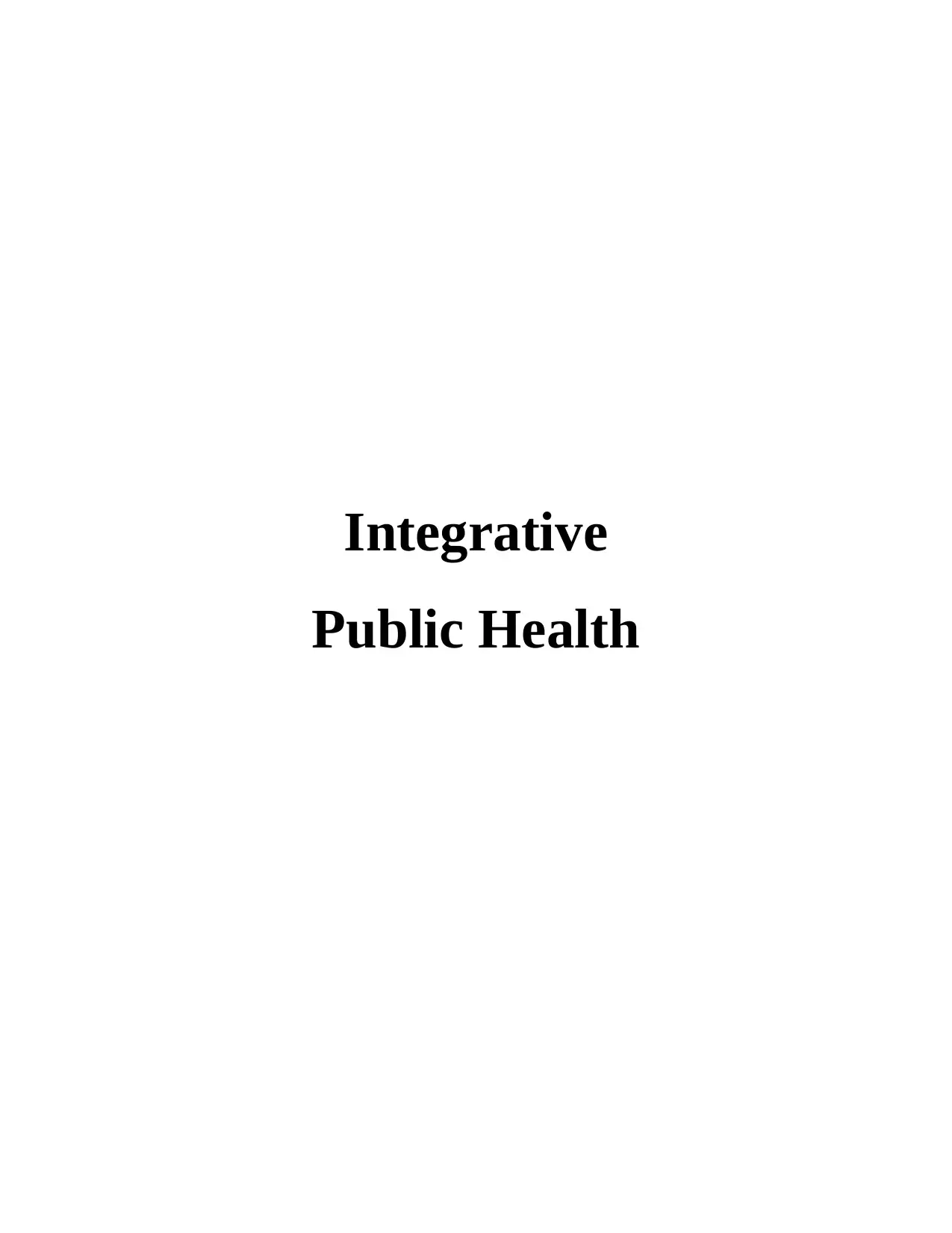
Integrative
Public Health
Public Health
Paraphrase This Document
Need a fresh take? Get an instant paraphrase of this document with our AI Paraphraser
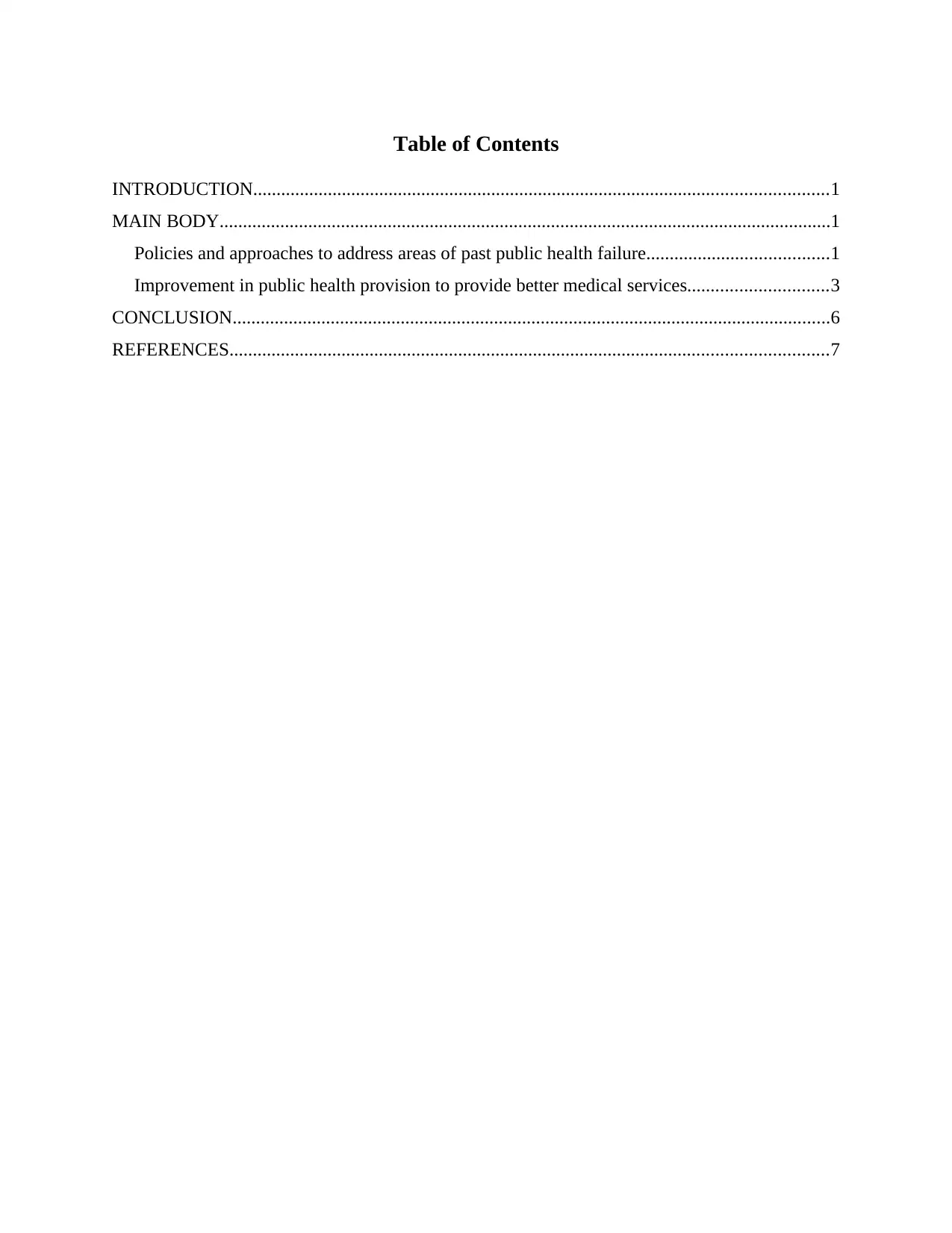
Table of Contents
INTRODUCTION...........................................................................................................................1
MAIN BODY...................................................................................................................................1
Policies and approaches to address areas of past public health failure.......................................1
Improvement in public health provision to provide better medical services..............................3
CONCLUSION................................................................................................................................6
REFERENCES................................................................................................................................7
INTRODUCTION...........................................................................................................................1
MAIN BODY...................................................................................................................................1
Policies and approaches to address areas of past public health failure.......................................1
Improvement in public health provision to provide better medical services..............................3
CONCLUSION................................................................................................................................6
REFERENCES................................................................................................................................7
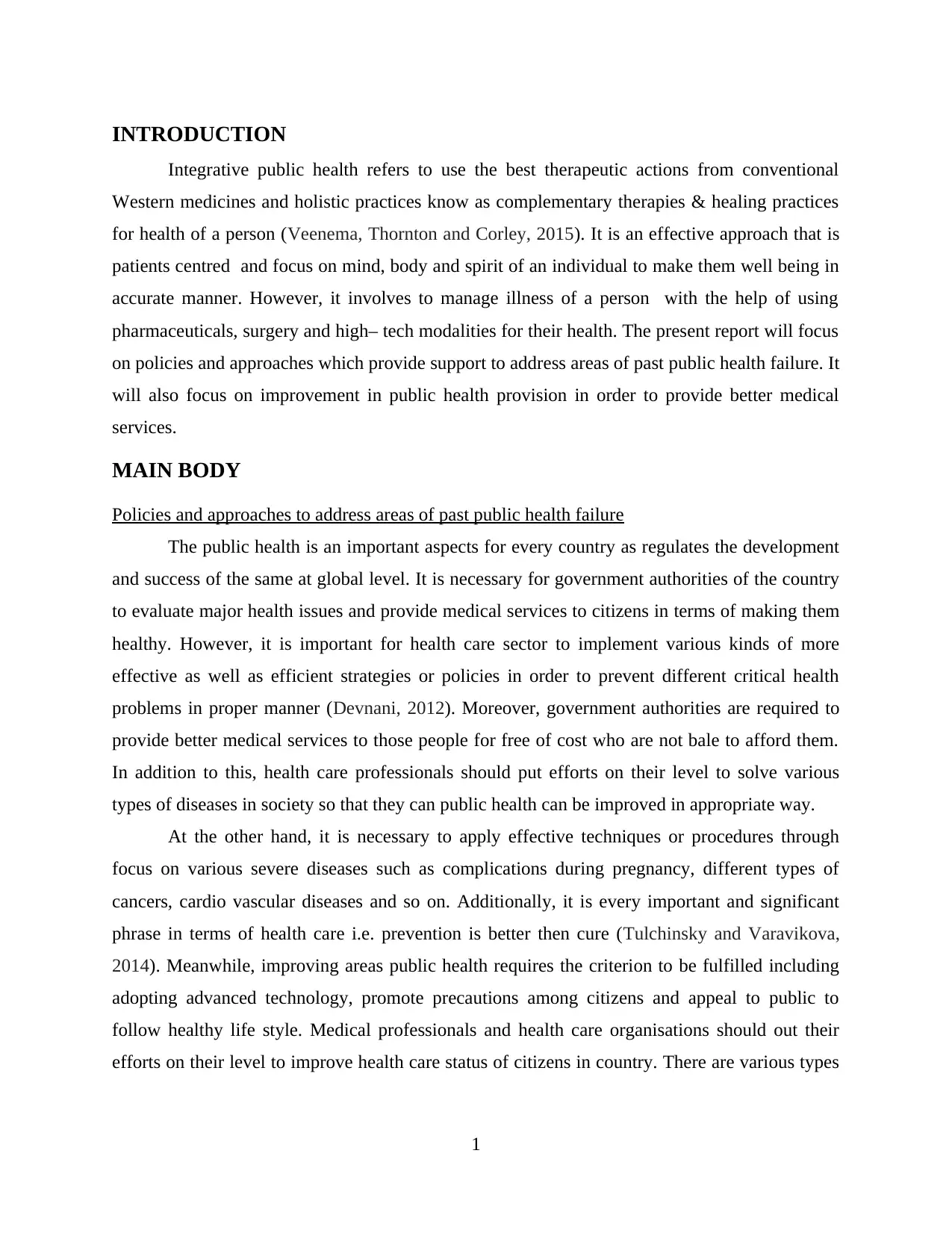
INTRODUCTION
Integrative public health refers to use the best therapeutic actions from conventional
Western medicines and holistic practices know as complementary therapies & healing practices
for health of a person (Veenema, Thornton and Corley, 2015). It is an effective approach that is
patients centred and focus on mind, body and spirit of an individual to make them well being in
accurate manner. However, it involves to manage illness of a person with the help of using
pharmaceuticals, surgery and high– tech modalities for their health. The present report will focus
on policies and approaches which provide support to address areas of past public health failure. It
will also focus on improvement in public health provision in order to provide better medical
services.
MAIN BODY
Policies and approaches to address areas of past public health failure
The public health is an important aspects for every country as regulates the development
and success of the same at global level. It is necessary for government authorities of the country
to evaluate major health issues and provide medical services to citizens in terms of making them
healthy. However, it is important for health care sector to implement various kinds of more
effective as well as efficient strategies or policies in order to prevent different critical health
problems in proper manner (Devnani, 2012). Moreover, government authorities are required to
provide better medical services to those people for free of cost who are not bale to afford them.
In addition to this, health care professionals should put efforts on their level to solve various
types of diseases in society so that they can public health can be improved in appropriate way.
At the other hand, it is necessary to apply effective techniques or procedures through
focus on various severe diseases such as complications during pregnancy, different types of
cancers, cardio vascular diseases and so on. Additionally, it is every important and significant
phrase in terms of health care i.e. prevention is better then cure (Tulchinsky and Varavikova,
2014). Meanwhile, improving areas public health requires the criterion to be fulfilled including
adopting advanced technology, promote precautions among citizens and appeal to public to
follow healthy life style. Medical professionals and health care organisations should out their
efforts on their level to improve health care status of citizens in country. There are various types
1
Integrative public health refers to use the best therapeutic actions from conventional
Western medicines and holistic practices know as complementary therapies & healing practices
for health of a person (Veenema, Thornton and Corley, 2015). It is an effective approach that is
patients centred and focus on mind, body and spirit of an individual to make them well being in
accurate manner. However, it involves to manage illness of a person with the help of using
pharmaceuticals, surgery and high– tech modalities for their health. The present report will focus
on policies and approaches which provide support to address areas of past public health failure. It
will also focus on improvement in public health provision in order to provide better medical
services.
MAIN BODY
Policies and approaches to address areas of past public health failure
The public health is an important aspects for every country as regulates the development
and success of the same at global level. It is necessary for government authorities of the country
to evaluate major health issues and provide medical services to citizens in terms of making them
healthy. However, it is important for health care sector to implement various kinds of more
effective as well as efficient strategies or policies in order to prevent different critical health
problems in proper manner (Devnani, 2012). Moreover, government authorities are required to
provide better medical services to those people for free of cost who are not bale to afford them.
In addition to this, health care professionals should put efforts on their level to solve various
types of diseases in society so that they can public health can be improved in appropriate way.
At the other hand, it is necessary to apply effective techniques or procedures through
focus on various severe diseases such as complications during pregnancy, different types of
cancers, cardio vascular diseases and so on. Additionally, it is every important and significant
phrase in terms of health care i.e. prevention is better then cure (Tulchinsky and Varavikova,
2014). Meanwhile, improving areas public health requires the criterion to be fulfilled including
adopting advanced technology, promote precautions among citizens and appeal to public to
follow healthy life style. Medical professionals and health care organisations should out their
efforts on their level to improve health care status of citizens in country. There are various types
1
⊘ This is a preview!⊘
Do you want full access?
Subscribe today to unlock all pages.

Trusted by 1+ million students worldwide
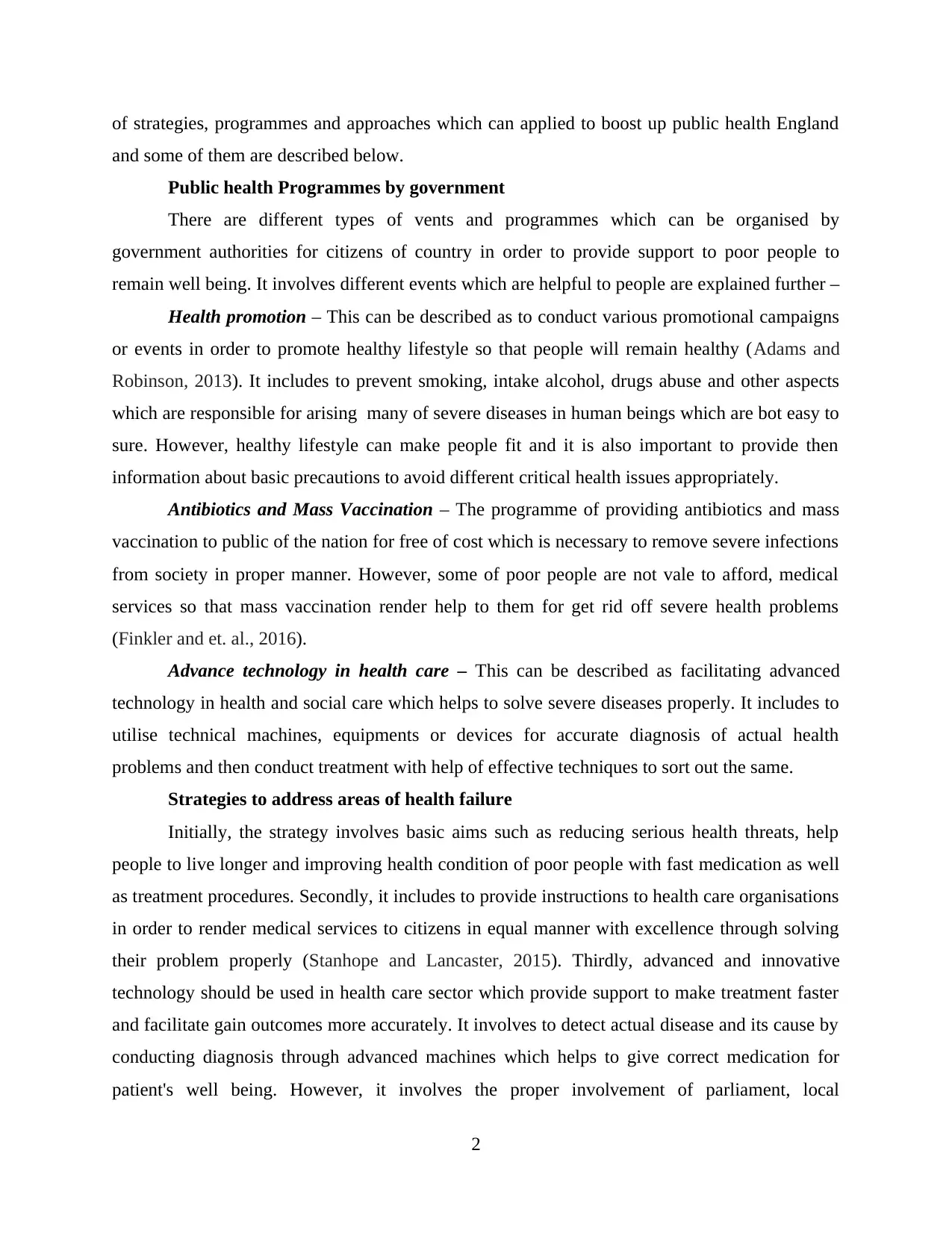
of strategies, programmes and approaches which can applied to boost up public health England
and some of them are described below.
Public health Programmes by government
There are different types of vents and programmes which can be organised by
government authorities for citizens of country in order to provide support to poor people to
remain well being. It involves different events which are helpful to people are explained further –
Health promotion – This can be described as to conduct various promotional campaigns
or events in order to promote healthy lifestyle so that people will remain healthy (Adams and
Robinson, 2013). It includes to prevent smoking, intake alcohol, drugs abuse and other aspects
which are responsible for arising many of severe diseases in human beings which are bot easy to
sure. However, healthy lifestyle can make people fit and it is also important to provide then
information about basic precautions to avoid different critical health issues appropriately.
Antibiotics and Mass Vaccination – The programme of providing antibiotics and mass
vaccination to public of the nation for free of cost which is necessary to remove severe infections
from society in proper manner. However, some of poor people are not vale to afford, medical
services so that mass vaccination render help to them for get rid off severe health problems
(Finkler and et. al., 2016).
Advance technology in health care – This can be described as facilitating advanced
technology in health and social care which helps to solve severe diseases properly. It includes to
utilise technical machines, equipments or devices for accurate diagnosis of actual health
problems and then conduct treatment with help of effective techniques to sort out the same.
Strategies to address areas of health failure
Initially, the strategy involves basic aims such as reducing serious health threats, help
people to live longer and improving health condition of poor people with fast medication as well
as treatment procedures. Secondly, it includes to provide instructions to health care organisations
in order to render medical services to citizens in equal manner with excellence through solving
their problem properly (Stanhope and Lancaster, 2015). Thirdly, advanced and innovative
technology should be used in health care sector which provide support to make treatment faster
and facilitate gain outcomes more accurately. It involves to detect actual disease and its cause by
conducting diagnosis through advanced machines which helps to give correct medication for
patient's well being. However, it involves the proper involvement of parliament, local
2
and some of them are described below.
Public health Programmes by government
There are different types of vents and programmes which can be organised by
government authorities for citizens of country in order to provide support to poor people to
remain well being. It involves different events which are helpful to people are explained further –
Health promotion – This can be described as to conduct various promotional campaigns
or events in order to promote healthy lifestyle so that people will remain healthy (Adams and
Robinson, 2013). It includes to prevent smoking, intake alcohol, drugs abuse and other aspects
which are responsible for arising many of severe diseases in human beings which are bot easy to
sure. However, healthy lifestyle can make people fit and it is also important to provide then
information about basic precautions to avoid different critical health issues appropriately.
Antibiotics and Mass Vaccination – The programme of providing antibiotics and mass
vaccination to public of the nation for free of cost which is necessary to remove severe infections
from society in proper manner. However, some of poor people are not vale to afford, medical
services so that mass vaccination render help to them for get rid off severe health problems
(Finkler and et. al., 2016).
Advance technology in health care – This can be described as facilitating advanced
technology in health and social care which helps to solve severe diseases properly. It includes to
utilise technical machines, equipments or devices for accurate diagnosis of actual health
problems and then conduct treatment with help of effective techniques to sort out the same.
Strategies to address areas of health failure
Initially, the strategy involves basic aims such as reducing serious health threats, help
people to live longer and improving health condition of poor people with fast medication as well
as treatment procedures. Secondly, it includes to provide instructions to health care organisations
in order to render medical services to citizens in equal manner with excellence through solving
their problem properly (Stanhope and Lancaster, 2015). Thirdly, advanced and innovative
technology should be used in health care sector which provide support to make treatment faster
and facilitate gain outcomes more accurately. It involves to detect actual disease and its cause by
conducting diagnosis through advanced machines which helps to give correct medication for
patient's well being. However, it involves the proper involvement of parliament, local
2
Paraphrase This Document
Need a fresh take? Get an instant paraphrase of this document with our AI Paraphraser
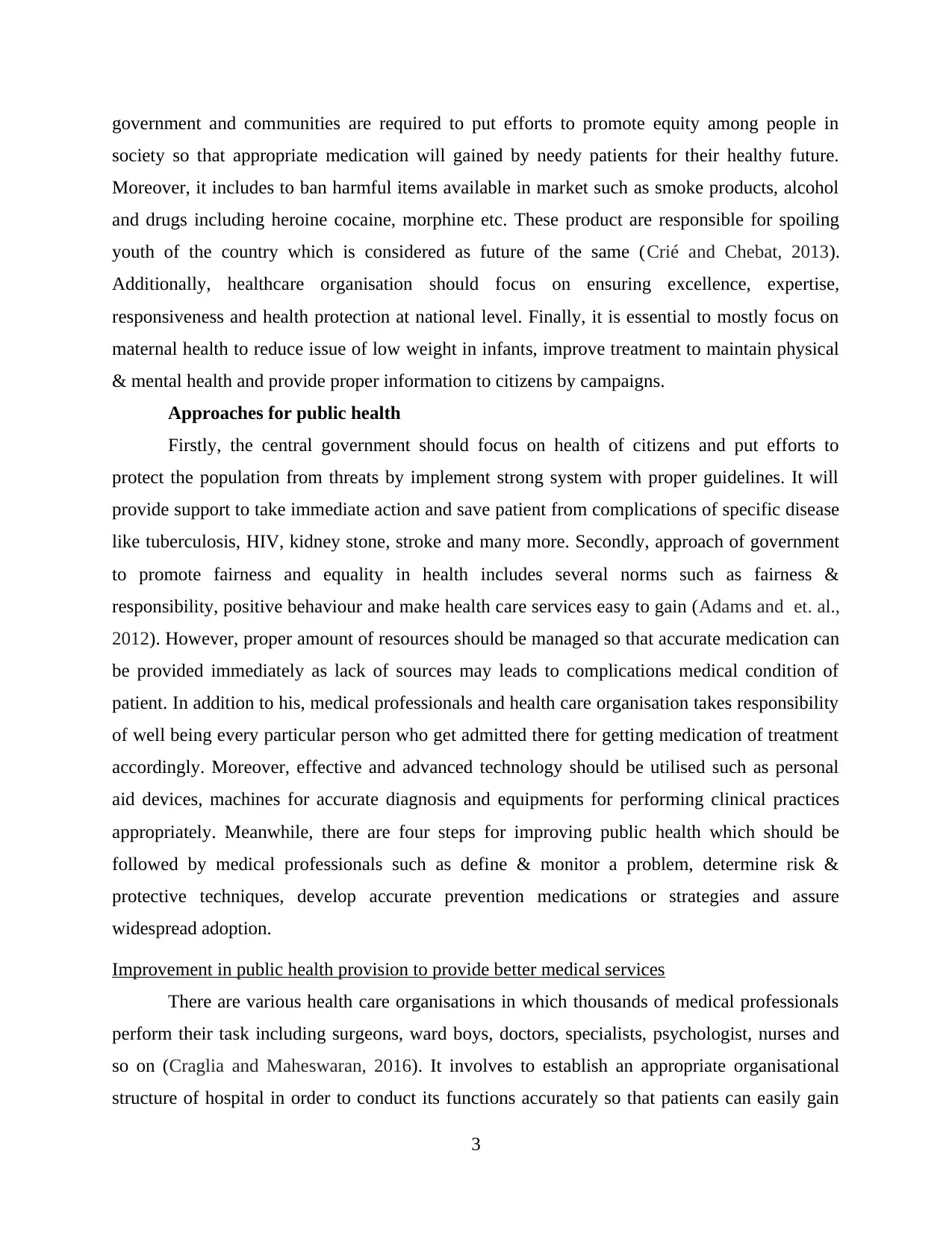
government and communities are required to put efforts to promote equity among people in
society so that appropriate medication will gained by needy patients for their healthy future.
Moreover, it includes to ban harmful items available in market such as smoke products, alcohol
and drugs including heroine cocaine, morphine etc. These product are responsible for spoiling
youth of the country which is considered as future of the same (Crié and Chebat, 2013).
Additionally, healthcare organisation should focus on ensuring excellence, expertise,
responsiveness and health protection at national level. Finally, it is essential to mostly focus on
maternal health to reduce issue of low weight in infants, improve treatment to maintain physical
& mental health and provide proper information to citizens by campaigns.
Approaches for public health
Firstly, the central government should focus on health of citizens and put efforts to
protect the population from threats by implement strong system with proper guidelines. It will
provide support to take immediate action and save patient from complications of specific disease
like tuberculosis, HIV, kidney stone, stroke and many more. Secondly, approach of government
to promote fairness and equality in health includes several norms such as fairness &
responsibility, positive behaviour and make health care services easy to gain (Adams and et. al.,
2012). However, proper amount of resources should be managed so that accurate medication can
be provided immediately as lack of sources may leads to complications medical condition of
patient. In addition to his, medical professionals and health care organisation takes responsibility
of well being every particular person who get admitted there for getting medication of treatment
accordingly. Moreover, effective and advanced technology should be utilised such as personal
aid devices, machines for accurate diagnosis and equipments for performing clinical practices
appropriately. Meanwhile, there are four steps for improving public health which should be
followed by medical professionals such as define & monitor a problem, determine risk &
protective techniques, develop accurate prevention medications or strategies and assure
widespread adoption.
Improvement in public health provision to provide better medical services
There are various health care organisations in which thousands of medical professionals
perform their task including surgeons, ward boys, doctors, specialists, psychologist, nurses and
so on (Craglia and Maheswaran, 2016). It involves to establish an appropriate organisational
structure of hospital in order to conduct its functions accurately so that patients can easily gain
3
society so that appropriate medication will gained by needy patients for their healthy future.
Moreover, it includes to ban harmful items available in market such as smoke products, alcohol
and drugs including heroine cocaine, morphine etc. These product are responsible for spoiling
youth of the country which is considered as future of the same (Crié and Chebat, 2013).
Additionally, healthcare organisation should focus on ensuring excellence, expertise,
responsiveness and health protection at national level. Finally, it is essential to mostly focus on
maternal health to reduce issue of low weight in infants, improve treatment to maintain physical
& mental health and provide proper information to citizens by campaigns.
Approaches for public health
Firstly, the central government should focus on health of citizens and put efforts to
protect the population from threats by implement strong system with proper guidelines. It will
provide support to take immediate action and save patient from complications of specific disease
like tuberculosis, HIV, kidney stone, stroke and many more. Secondly, approach of government
to promote fairness and equality in health includes several norms such as fairness &
responsibility, positive behaviour and make health care services easy to gain (Adams and et. al.,
2012). However, proper amount of resources should be managed so that accurate medication can
be provided immediately as lack of sources may leads to complications medical condition of
patient. In addition to his, medical professionals and health care organisation takes responsibility
of well being every particular person who get admitted there for getting medication of treatment
accordingly. Moreover, effective and advanced technology should be utilised such as personal
aid devices, machines for accurate diagnosis and equipments for performing clinical practices
appropriately. Meanwhile, there are four steps for improving public health which should be
followed by medical professionals such as define & monitor a problem, determine risk &
protective techniques, develop accurate prevention medications or strategies and assure
widespread adoption.
Improvement in public health provision to provide better medical services
There are various health care organisations in which thousands of medical professionals
perform their task including surgeons, ward boys, doctors, specialists, psychologist, nurses and
so on (Craglia and Maheswaran, 2016). It involves to establish an appropriate organisational
structure of hospital in order to conduct its functions accurately so that patients can easily gain
3
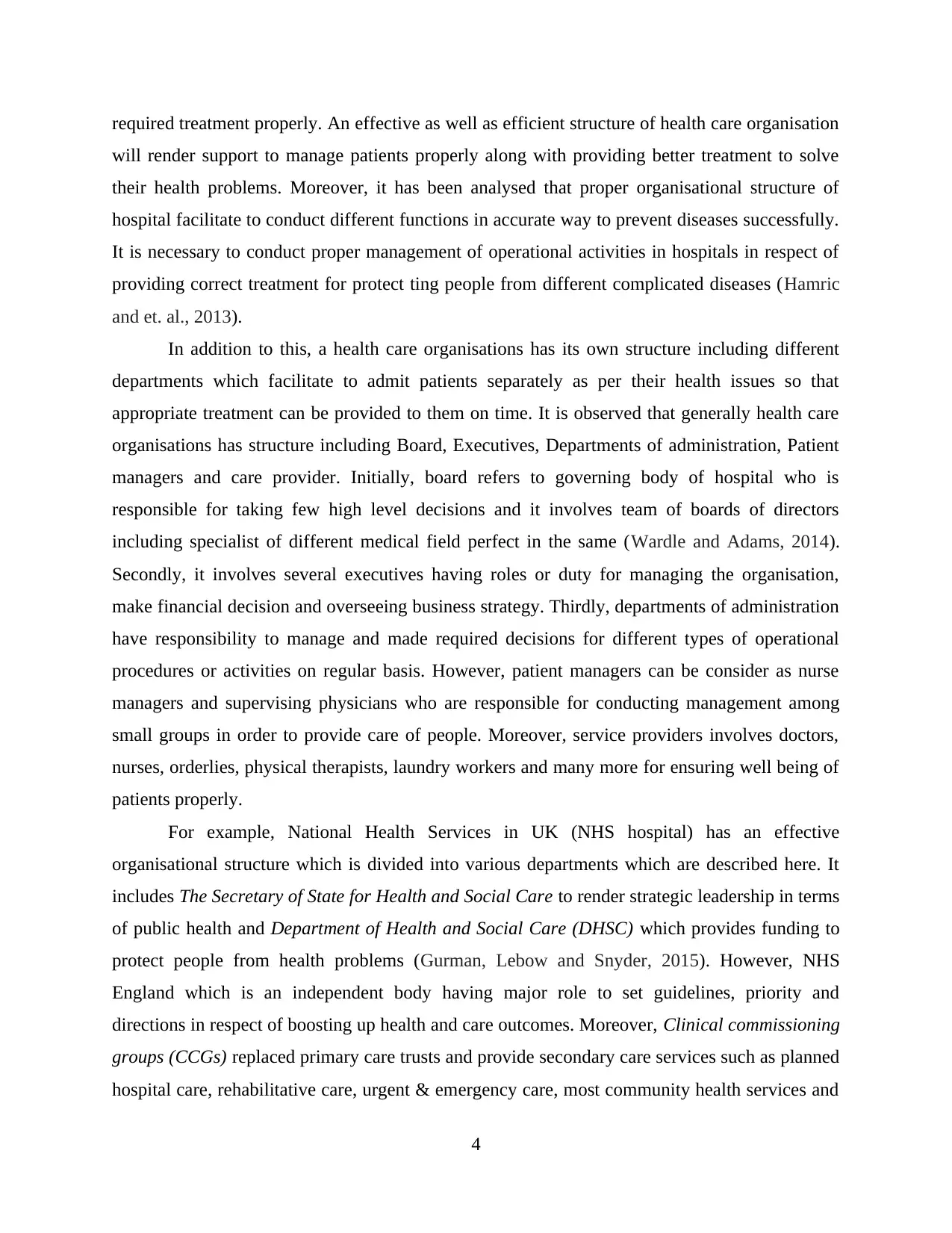
required treatment properly. An effective as well as efficient structure of health care organisation
will render support to manage patients properly along with providing better treatment to solve
their health problems. Moreover, it has been analysed that proper organisational structure of
hospital facilitate to conduct different functions in accurate way to prevent diseases successfully.
It is necessary to conduct proper management of operational activities in hospitals in respect of
providing correct treatment for protect ting people from different complicated diseases (Hamric
and et. al., 2013).
In addition to this, a health care organisations has its own structure including different
departments which facilitate to admit patients separately as per their health issues so that
appropriate treatment can be provided to them on time. It is observed that generally health care
organisations has structure including Board, Executives, Departments of administration, Patient
managers and care provider. Initially, board refers to governing body of hospital who is
responsible for taking few high level decisions and it involves team of boards of directors
including specialist of different medical field perfect in the same (Wardle and Adams, 2014).
Secondly, it involves several executives having roles or duty for managing the organisation,
make financial decision and overseeing business strategy. Thirdly, departments of administration
have responsibility to manage and made required decisions for different types of operational
procedures or activities on regular basis. However, patient managers can be consider as nurse
managers and supervising physicians who are responsible for conducting management among
small groups in order to provide care of people. Moreover, service providers involves doctors,
nurses, orderlies, physical therapists, laundry workers and many more for ensuring well being of
patients properly.
For example, National Health Services in UK (NHS hospital) has an effective
organisational structure which is divided into various departments which are described here. It
includes The Secretary of State for Health and Social Care to render strategic leadership in terms
of public health and Department of Health and Social Care (DHSC) which provides funding to
protect people from health problems (Gurman, Lebow and Snyder, 2015). However, NHS
England which is an independent body having major role to set guidelines, priority and
directions in respect of boosting up health and care outcomes. Moreover, Clinical commissioning
groups (CCGs) replaced primary care trusts and provide secondary care services such as planned
hospital care, rehabilitative care, urgent & emergency care, most community health services and
4
will render support to manage patients properly along with providing better treatment to solve
their health problems. Moreover, it has been analysed that proper organisational structure of
hospital facilitate to conduct different functions in accurate way to prevent diseases successfully.
It is necessary to conduct proper management of operational activities in hospitals in respect of
providing correct treatment for protect ting people from different complicated diseases (Hamric
and et. al., 2013).
In addition to this, a health care organisations has its own structure including different
departments which facilitate to admit patients separately as per their health issues so that
appropriate treatment can be provided to them on time. It is observed that generally health care
organisations has structure including Board, Executives, Departments of administration, Patient
managers and care provider. Initially, board refers to governing body of hospital who is
responsible for taking few high level decisions and it involves team of boards of directors
including specialist of different medical field perfect in the same (Wardle and Adams, 2014).
Secondly, it involves several executives having roles or duty for managing the organisation,
make financial decision and overseeing business strategy. Thirdly, departments of administration
have responsibility to manage and made required decisions for different types of operational
procedures or activities on regular basis. However, patient managers can be consider as nurse
managers and supervising physicians who are responsible for conducting management among
small groups in order to provide care of people. Moreover, service providers involves doctors,
nurses, orderlies, physical therapists, laundry workers and many more for ensuring well being of
patients properly.
For example, National Health Services in UK (NHS hospital) has an effective
organisational structure which is divided into various departments which are described here. It
includes The Secretary of State for Health and Social Care to render strategic leadership in terms
of public health and Department of Health and Social Care (DHSC) which provides funding to
protect people from health problems (Gurman, Lebow and Snyder, 2015). However, NHS
England which is an independent body having major role to set guidelines, priority and
directions in respect of boosting up health and care outcomes. Moreover, Clinical commissioning
groups (CCGs) replaced primary care trusts and provide secondary care services such as planned
hospital care, rehabilitative care, urgent & emergency care, most community health services and
4
⊘ This is a preview!⊘
Do you want full access?
Subscribe today to unlock all pages.

Trusted by 1+ million students worldwide
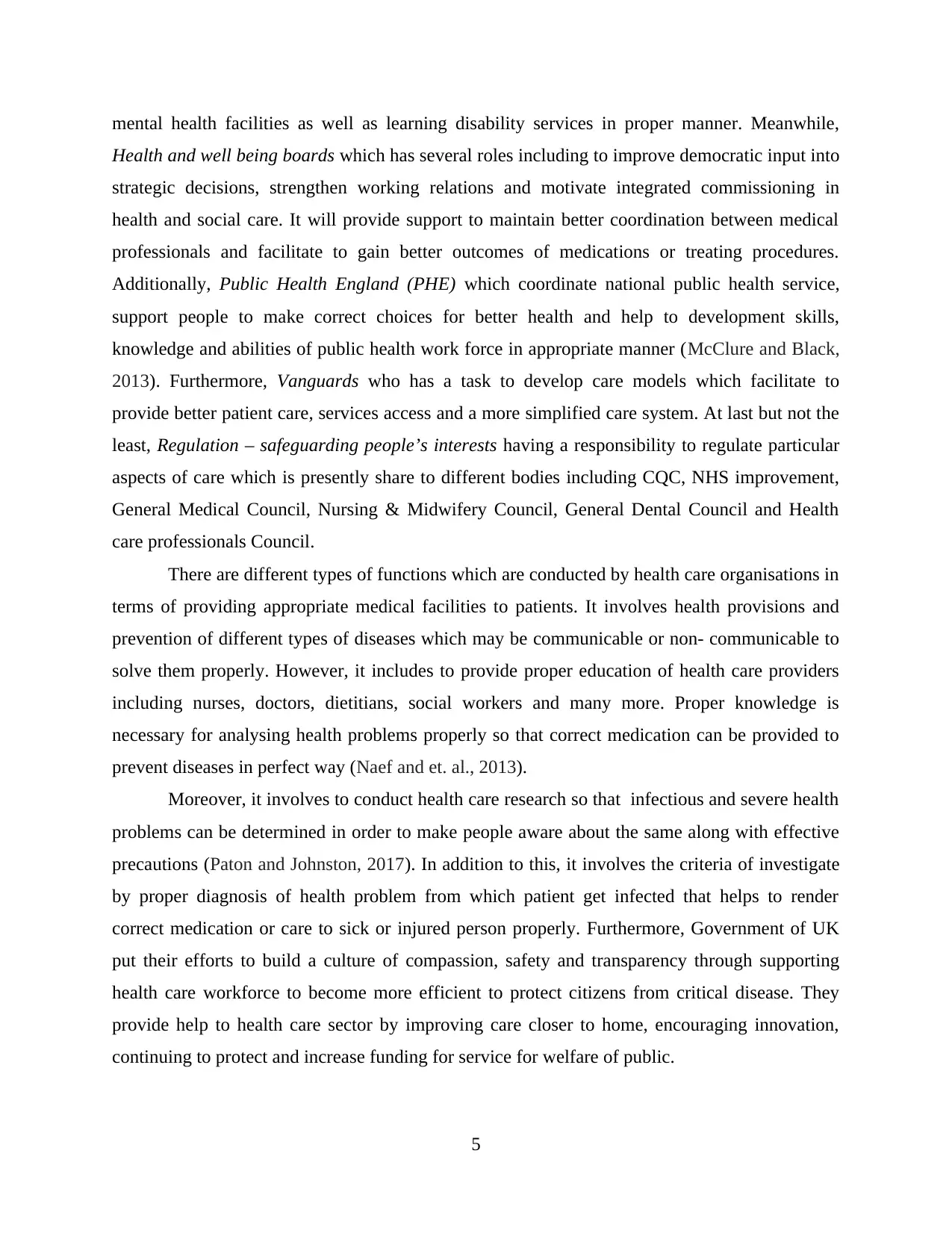
mental health facilities as well as learning disability services in proper manner. Meanwhile,
Health and well being boards which has several roles including to improve democratic input into
strategic decisions, strengthen working relations and motivate integrated commissioning in
health and social care. It will provide support to maintain better coordination between medical
professionals and facilitate to gain better outcomes of medications or treating procedures.
Additionally, Public Health England (PHE) which coordinate national public health service,
support people to make correct choices for better health and help to development skills,
knowledge and abilities of public health work force in appropriate manner (McClure and Black,
2013). Furthermore, Vanguards who has a task to develop care models which facilitate to
provide better patient care, services access and a more simplified care system. At last but not the
least, Regulation – safeguarding people’s interests having a responsibility to regulate particular
aspects of care which is presently share to different bodies including CQC, NHS improvement,
General Medical Council, Nursing & Midwifery Council, General Dental Council and Health
care professionals Council.
There are different types of functions which are conducted by health care organisations in
terms of providing appropriate medical facilities to patients. It involves health provisions and
prevention of different types of diseases which may be communicable or non- communicable to
solve them properly. However, it includes to provide proper education of health care providers
including nurses, doctors, dietitians, social workers and many more. Proper knowledge is
necessary for analysing health problems properly so that correct medication can be provided to
prevent diseases in perfect way (Naef and et. al., 2013).
Moreover, it involves to conduct health care research so that infectious and severe health
problems can be determined in order to make people aware about the same along with effective
precautions (Paton and Johnston, 2017). In addition to this, it involves the criteria of investigate
by proper diagnosis of health problem from which patient get infected that helps to render
correct medication or care to sick or injured person properly. Furthermore, Government of UK
put their efforts to build a culture of compassion, safety and transparency through supporting
health care workforce to become more efficient to protect citizens from critical disease. They
provide help to health care sector by improving care closer to home, encouraging innovation,
continuing to protect and increase funding for service for welfare of public.
5
Health and well being boards which has several roles including to improve democratic input into
strategic decisions, strengthen working relations and motivate integrated commissioning in
health and social care. It will provide support to maintain better coordination between medical
professionals and facilitate to gain better outcomes of medications or treating procedures.
Additionally, Public Health England (PHE) which coordinate national public health service,
support people to make correct choices for better health and help to development skills,
knowledge and abilities of public health work force in appropriate manner (McClure and Black,
2013). Furthermore, Vanguards who has a task to develop care models which facilitate to
provide better patient care, services access and a more simplified care system. At last but not the
least, Regulation – safeguarding people’s interests having a responsibility to regulate particular
aspects of care which is presently share to different bodies including CQC, NHS improvement,
General Medical Council, Nursing & Midwifery Council, General Dental Council and Health
care professionals Council.
There are different types of functions which are conducted by health care organisations in
terms of providing appropriate medical facilities to patients. It involves health provisions and
prevention of different types of diseases which may be communicable or non- communicable to
solve them properly. However, it includes to provide proper education of health care providers
including nurses, doctors, dietitians, social workers and many more. Proper knowledge is
necessary for analysing health problems properly so that correct medication can be provided to
prevent diseases in perfect way (Naef and et. al., 2013).
Moreover, it involves to conduct health care research so that infectious and severe health
problems can be determined in order to make people aware about the same along with effective
precautions (Paton and Johnston, 2017). In addition to this, it involves the criteria of investigate
by proper diagnosis of health problem from which patient get infected that helps to render
correct medication or care to sick or injured person properly. Furthermore, Government of UK
put their efforts to build a culture of compassion, safety and transparency through supporting
health care workforce to become more efficient to protect citizens from critical disease. They
provide help to health care sector by improving care closer to home, encouraging innovation,
continuing to protect and increase funding for service for welfare of public.
5
Paraphrase This Document
Need a fresh take? Get an instant paraphrase of this document with our AI Paraphraser
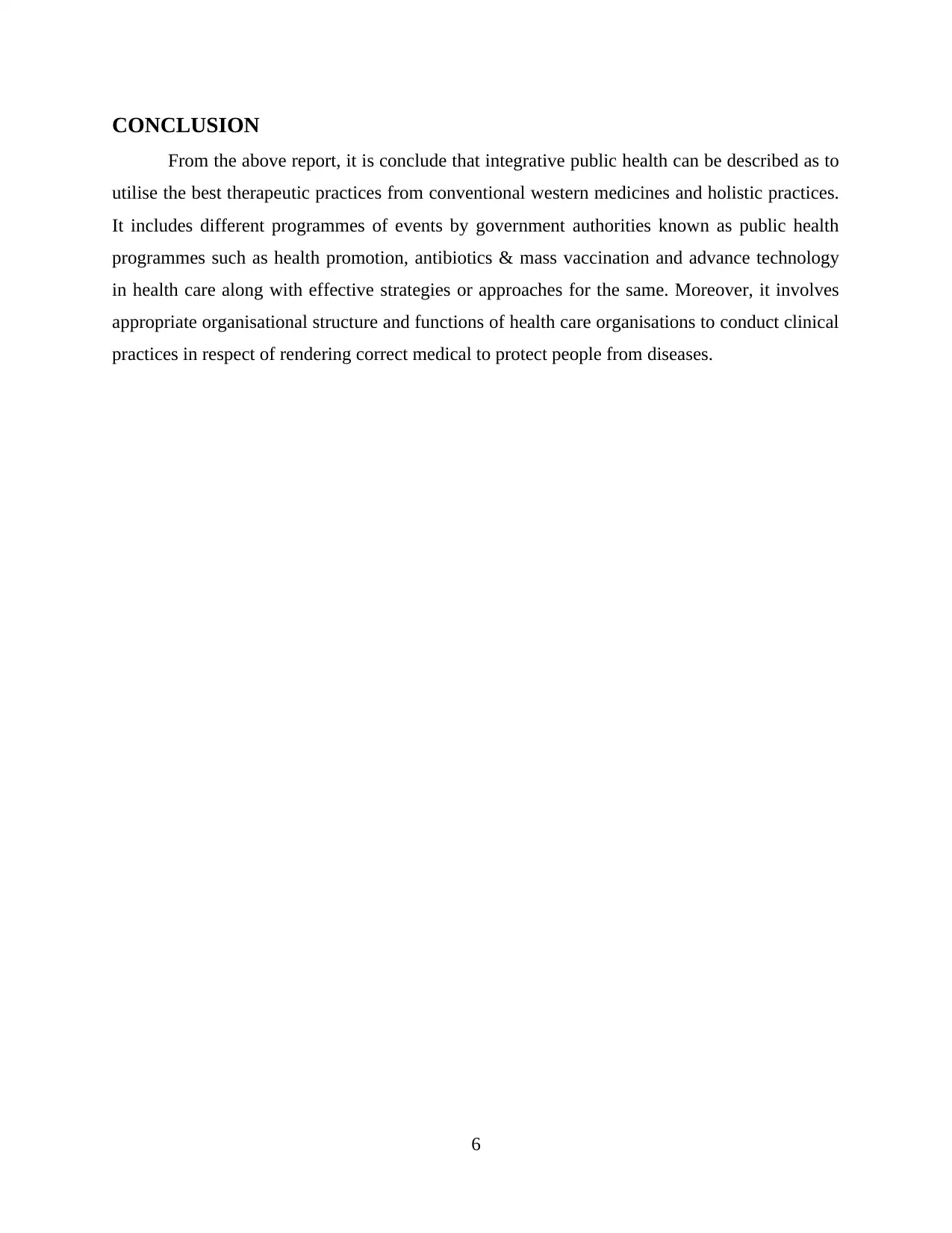
CONCLUSION
From the above report, it is conclude that integrative public health can be described as to
utilise the best therapeutic practices from conventional western medicines and holistic practices.
It includes different programmes of events by government authorities known as public health
programmes such as health promotion, antibiotics & mass vaccination and advance technology
in health care along with effective strategies or approaches for the same. Moreover, it involves
appropriate organisational structure and functions of health care organisations to conduct clinical
practices in respect of rendering correct medical to protect people from diseases.
6
From the above report, it is conclude that integrative public health can be described as to
utilise the best therapeutic practices from conventional western medicines and holistic practices.
It includes different programmes of events by government authorities known as public health
programmes such as health promotion, antibiotics & mass vaccination and advance technology
in health care along with effective strategies or approaches for the same. Moreover, it involves
appropriate organisational structure and functions of health care organisations to conduct clinical
practices in respect of rendering correct medical to protect people from diseases.
6
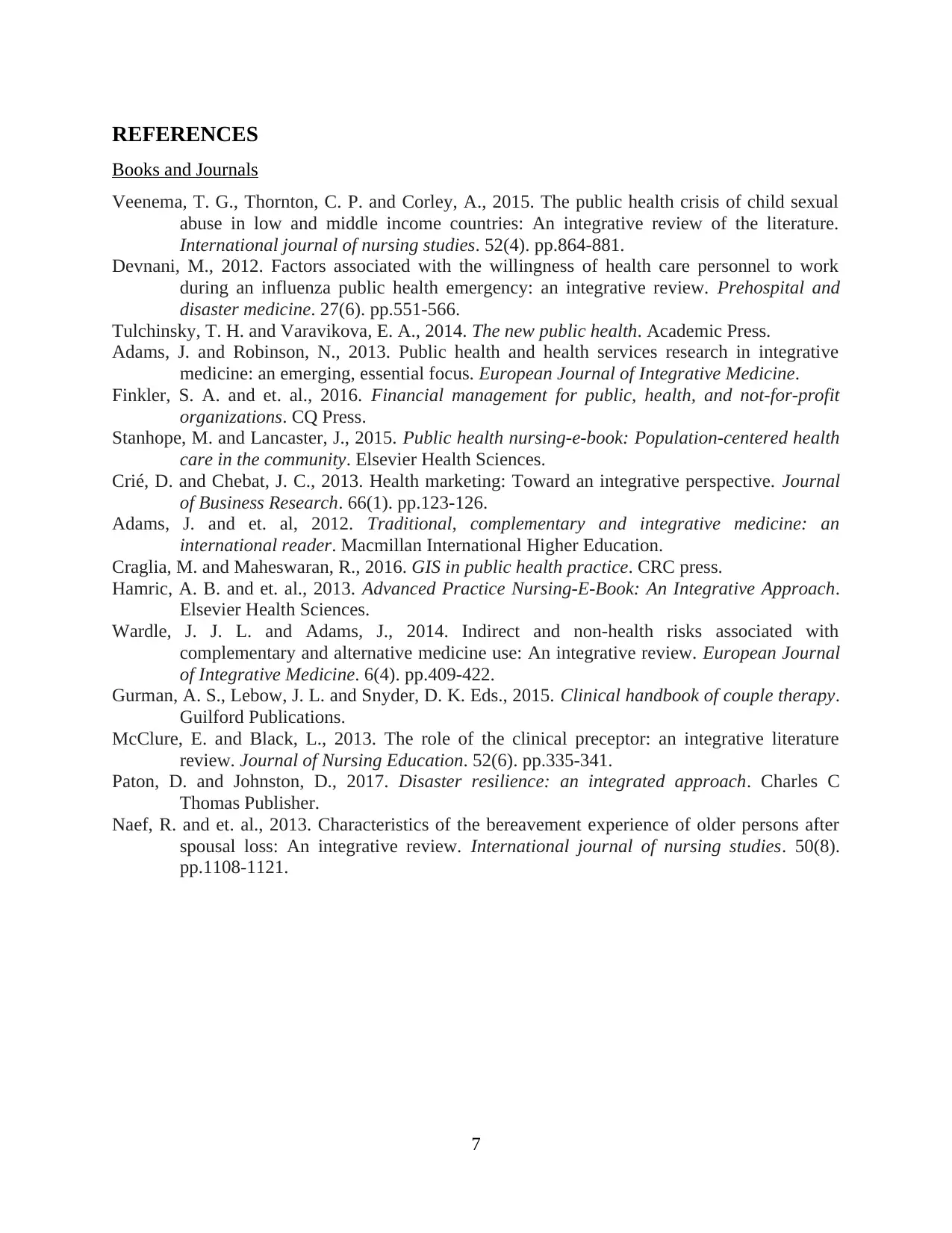
REFERENCES
Books and Journals
Veenema, T. G., Thornton, C. P. and Corley, A., 2015. The public health crisis of child sexual
abuse in low and middle income countries: An integrative review of the literature.
International journal of nursing studies. 52(4). pp.864-881.
Devnani, M., 2012. Factors associated with the willingness of health care personnel to work
during an influenza public health emergency: an integrative review. Prehospital and
disaster medicine. 27(6). pp.551-566.
Tulchinsky, T. H. and Varavikova, E. A., 2014. The new public health. Academic Press.
Adams, J. and Robinson, N., 2013. Public health and health services research in integrative
medicine: an emerging, essential focus. European Journal of Integrative Medicine.
Finkler, S. A. and et. al., 2016. Financial management for public, health, and not-for-profit
organizations. CQ Press.
Stanhope, M. and Lancaster, J., 2015. Public health nursing-e-book: Population-centered health
care in the community. Elsevier Health Sciences.
Crié, D. and Chebat, J. C., 2013. Health marketing: Toward an integrative perspective. Journal
of Business Research. 66(1). pp.123-126.
Adams, J. and et. al, 2012. Traditional, complementary and integrative medicine: an
international reader. Macmillan International Higher Education.
Craglia, M. and Maheswaran, R., 2016. GIS in public health practice. CRC press.
Hamric, A. B. and et. al., 2013. Advanced Practice Nursing-E-Book: An Integrative Approach.
Elsevier Health Sciences.
Wardle, J. J. L. and Adams, J., 2014. Indirect and non-health risks associated with
complementary and alternative medicine use: An integrative review. European Journal
of Integrative Medicine. 6(4). pp.409-422.
Gurman, A. S., Lebow, J. L. and Snyder, D. K. Eds., 2015. Clinical handbook of couple therapy.
Guilford Publications.
McClure, E. and Black, L., 2013. The role of the clinical preceptor: an integrative literature
review. Journal of Nursing Education. 52(6). pp.335-341.
Paton, D. and Johnston, D., 2017. Disaster resilience: an integrated approach. Charles C
Thomas Publisher.
Naef, R. and et. al., 2013. Characteristics of the bereavement experience of older persons after
spousal loss: An integrative review. International journal of nursing studies. 50(8).
pp.1108-1121.
7
Books and Journals
Veenema, T. G., Thornton, C. P. and Corley, A., 2015. The public health crisis of child sexual
abuse in low and middle income countries: An integrative review of the literature.
International journal of nursing studies. 52(4). pp.864-881.
Devnani, M., 2012. Factors associated with the willingness of health care personnel to work
during an influenza public health emergency: an integrative review. Prehospital and
disaster medicine. 27(6). pp.551-566.
Tulchinsky, T. H. and Varavikova, E. A., 2014. The new public health. Academic Press.
Adams, J. and Robinson, N., 2013. Public health and health services research in integrative
medicine: an emerging, essential focus. European Journal of Integrative Medicine.
Finkler, S. A. and et. al., 2016. Financial management for public, health, and not-for-profit
organizations. CQ Press.
Stanhope, M. and Lancaster, J., 2015. Public health nursing-e-book: Population-centered health
care in the community. Elsevier Health Sciences.
Crié, D. and Chebat, J. C., 2013. Health marketing: Toward an integrative perspective. Journal
of Business Research. 66(1). pp.123-126.
Adams, J. and et. al, 2012. Traditional, complementary and integrative medicine: an
international reader. Macmillan International Higher Education.
Craglia, M. and Maheswaran, R., 2016. GIS in public health practice. CRC press.
Hamric, A. B. and et. al., 2013. Advanced Practice Nursing-E-Book: An Integrative Approach.
Elsevier Health Sciences.
Wardle, J. J. L. and Adams, J., 2014. Indirect and non-health risks associated with
complementary and alternative medicine use: An integrative review. European Journal
of Integrative Medicine. 6(4). pp.409-422.
Gurman, A. S., Lebow, J. L. and Snyder, D. K. Eds., 2015. Clinical handbook of couple therapy.
Guilford Publications.
McClure, E. and Black, L., 2013. The role of the clinical preceptor: an integrative literature
review. Journal of Nursing Education. 52(6). pp.335-341.
Paton, D. and Johnston, D., 2017. Disaster resilience: an integrated approach. Charles C
Thomas Publisher.
Naef, R. and et. al., 2013. Characteristics of the bereavement experience of older persons after
spousal loss: An integrative review. International journal of nursing studies. 50(8).
pp.1108-1121.
7
⊘ This is a preview!⊘
Do you want full access?
Subscribe today to unlock all pages.

Trusted by 1+ million students worldwide
1 out of 9
Related Documents
Your All-in-One AI-Powered Toolkit for Academic Success.
+13062052269
info@desklib.com
Available 24*7 on WhatsApp / Email
![[object Object]](/_next/static/media/star-bottom.7253800d.svg)
Unlock your academic potential
Copyright © 2020–2025 A2Z Services. All Rights Reserved. Developed and managed by ZUCOL.





